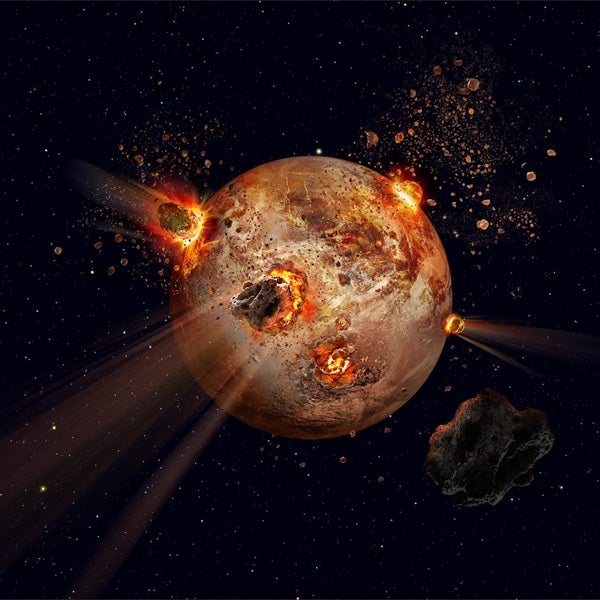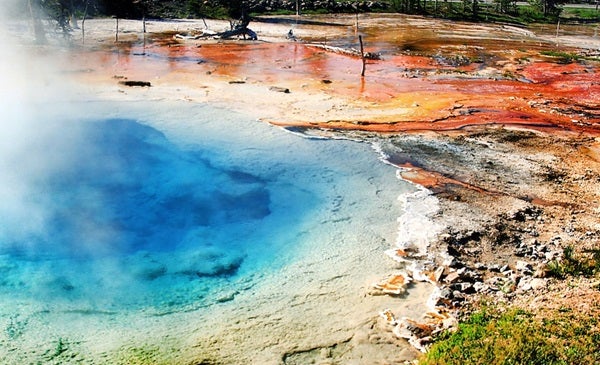This story comes from our special January 2021 issue, “The Beginning and the End of the Universe.” Click here to purchase the full issue.
Four billion years ago, eight burgeoning planets — including a water-rich world under fire — lurked within the debris disk around a young star. The Sun’s primordial nebular gas was gone, but interplanetary space remained filled with rocky debris that pummeled planetary surfaces. The largest impacts stripped developing atmospheres and spewed melted rock into space, flinging bits of planets across the solar system.
Due to this onslaught, Earth’s surface was repeatedly resculpted. The largest asteroids vaporized early seas and rock, melting the crust within each crater and creating a thick cloud of particulates that temporarily blocked sunlight from reaching Earth’s surface. The molten sheets of magma, or melt sheets, created during these impacts were as deep as modern oceans, and they also heated groundwater within the nearby crust, kickstarting hydrothermal activity. This spawned enormous versions of sites like the Yellowstone volcanic caldera, churning hot water up to the surface.
Yet, this landscape may not have been as inhospitable as it may seem. Scientists have long studied places like Yellowstone and other volcanic hydrothermal systems as analogues for Earth’s oldest microbial ecosystems. But in recent years, researchers have examined another idea, wondering if impact-generated hydrothermal systems instead might hold vital clues about how life on ancient Earth first formed.
A shot at life
The Impact-Origin of Life Hypothesis suggests the bombardment Earth experienced some 4 billion years ago created vast subsurface hydrothermal systems that were ideal crucibles for prebiotic chemistry and the early evolution of life. And even if life didn’t originate in those subterranean liquid conduits, the sites still would have been attractive refuges for any microbial colonies already alive when Earth’s seas were vaporized by impacts.
The surface of the Hadean Earth described above has long since eroded or been swallowed by the Earth’s crust. But we can still get a glimpse of this lost landscape thanks to the 66-million-year-old Chicxulub impact crater on the Yucatan Peninsula. Best known as the epicenter of the dinosaurs’ hellish demise, the crater is now taking a central role for research into the origins of life.
In recent years, scientists have studied Chicxulub crater by drilling deep boreholes and sending probes into the crust. These efforts have resulted in many samples of the once-dynamic impact site, revealing a post-strike cauldron of molten rock and circulating hot water.
Following the impact, Chicxulub crater’s hydrothermal system was nearly 10 times larger than the Yellowstone caldera, spanning virtually the entire 112-mile-wide (180 kilometer) basin. But activity was especially intense near the peak ring inside the crater, which surrounded the central melt sheet. Groundwater flowed beneath the outskirts of the crater, taking advantage of porous, permeable rock created during the impact event. With temperatures exceeding 572 degrees Fahrenheit (300 degrees Celsius), this hot and mineral-laden water circulated up from depths as great as 3.1 miles (5 km).
Such systems were prevalent during the impact bombardment that shaped the Hadean. Estimates of the size and frequency of impactors vary, but one model suggests our planet was resurfaced by about 6,000 impactors, each larger than the roughly 6-mile-wide (10 km) Chicxulub impactor. Those impactors may have produced some 200 impact craters 620 to 3,100 miles (1,000 to 5,000 km) in diameter, each a potential incubator for microbial life. These impact-generated hydrothermal systems may have been far more expansive (and common) than volcanic systems, like those at Yellowstone and along mid-ocean ridges today.
The right ingredients
Having the proper temperature is only part of the recipe for cooking up life — the right ingredients in the Earth’s crust are also necessary.
While today’s atmosphere is mostly nitrogen and oxygen, the Hadean atmosphere may have instead been dominated by hydrogen, carbon dioxide, carbon monoxide, and ammonia, before being filled with steam and rock vapor produced by the largest impact events. As intense ultraviolet rays from the young Sun beat down on that post-impact, debris-filled atmosphere, it could have generated a hydrocarbon haze in the sky, casting a deep yellow-orange smog that eventually settled to the surface, forming hydrocarbon-rich sediment layers on top of multi-mile thick layers of impact ejecta.
Hot, mineral-rich water venting through those rubble piles of hydrocarbon-rich sediments would have been chemical factories for organic reactions, providing the necessary feed stock for microbial ecosystems. If one had an ear for hydrothermal activity following a strike, one might even hear roaring gases venting at the surface of ring-shaped island chains surrounding the centers of impact sites, with plumes of bubbling fumes and dissolved pollutants thrumming above the seafloor, and Earth itself creaking as the crater settled.
An uncertain past
The plumbing of a hydrothermal system may have shifted, too, suddenly growing silent in one area while booming in another as earthquakes caused by other impacts changed water pressures and closed vents through collapse, cutting off hydrothermal channels. Still, these fluctuations wouldn’t mean all life there was snuffed out. Organisms already living in these environments would have dutifully migrated throughout Earth’s crust, following the fluids that provided the necessary temperatures and nutrients to drive metabolic reactions.
Microbial ecosystems even may have eventually breached the surface and spread across the floors of impact craters. Any life that emerged would have had only a short time to thrive, however, before being decimated or extinguished entirely by the next large impact. But such was life on Earth, at least until the basin-forming impact epoch ended.
The Impact-Origin of Life Hypothesis has its rivals, but many competing ideas still rely on hydrothermal fluids. In one such model, the spreading centers of oceanic crust produced the mineral-rich setting that was necessary for life to form. Other models envision continental hydrothermal sites, not unlike the volcanic edifices at Yellowstone. So, while each possible scenario has its own unique attributes, a complex site with heated, mineral-rich fluid is the common thread linking many of them.
At this point in time, existing evidence cannot resolve an impact origin of life from a volcanic origin of life. However, in a heavily impact-cratered Hadean world, it is important to understand that those alternative types of hydrothermal systems existed in a landscape shaped by impact basins. So, one way or another, life may have emerged from an impact crater, either from an impact-generated hydrothermal system as described here, or from a volcanic hydrothermal system that grew within one of those impact sites.













